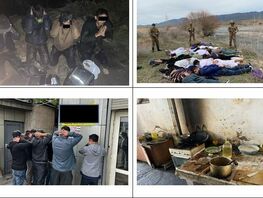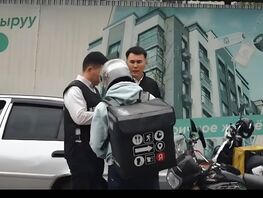Economy of Kyrgyzstan is highly dependent on the operation of Kumtor mine. Gold-rich ore was mined at the field in 2019, so industrial growth indicators were mainly associated with the mining industry.
However, there is still no order in the mining sector of the country. Locals continue to rally against mining.
The fact that the deadlines for transition periods on some technical regulations of the Eurasian Economic Union (EAEU) have ended also adds some problems. Experts suggest that this will influence the state of the economy not in the best way in 2020.
Everything depends on gold
Everything looked more than optimistic at the beginning of 2019. Gold-rich ore was mined at Kumtor. The country’s GDP reacted positively. Already in January, when business activity usually stands still, economic growth indicators amounted to 6.4 percent.
Experts immediately warned — don’t get excited too soon. Indeed, a decrease in precious metal production and a slowdown in economic growth were expected in the second half of the year. The first evidence appeared in April 2019, when GDP growth slowed by 0.7 percent compared to January.
Since August, economic growth has been gradually slowing down and reached 4.9 percent by the end of November.
Aigul Berdigulova, an Analyst for the Eurasian Development Bank, in an interview with 24.kg news agency noted that the economic activity of the first half of 2019 was replaced by its slowdown. This was mainly determined by the dynamics of production at Kumtor gold mining enterprise.
«Support for the economy during 2019 was provided by domestic consumer demand amid rising real cash incomes and expanding investment activity. As a result, according to the EDB, the country’s final GDP growth in 2019 will be 4 percent,» the expert said.
Against uranium and gold
The past year was also marked by a fierce struggle of the Kyrgyzstanis against development of mineral resources. Over the years of independence, we have probably got used to the fact that any mining projects are accompanied by scandals. But 2019 will be especially remembered.
It all started with a project on development of Kyzyl-Ompol uranium deposit in Issyk-Kul region. It was planned that uranium and thorium would be mined in Ton district, and processed at Kara-Balta Mining Plant. However, mass rallies against the project began in February.
A rally in Bishkek at the end of April was the culmination. It was followed by a bill banning mining and development of uranium in the country.
Dust settled, and the bill caused much controversy in the Parliament. However, in the end, the deputies accepted it, and the President signed it.
But the showdown with investors and subsoil developers did not end with the uranium scandal. A conflict broke out between local residents and Chinese workers at Solton-Sary field in Naryn region in August. About 300 villagers participated in a rally.
They demanded to suspend the activities of the gold mining Chinese company Zhong Ji Mining. As a result, a conflict occurred between the protesters and the workers; the parties threw stones at each other.
As a result of the clashes at Solton-Sary field, 20 victims were provided with medical assistance.
It almost came to an international scandal. The Embassy of China published a harsh statement calling the incident an attack on the Chinese company. Chinese diplomats asked the Government and relevant departments of Kyrgyzstan to take effective measures to protect the legitimate rights and interests of Chinese enterprises, ensure safety of Chinese citizens and prevent recurrence of such incidents.
The protest has lasted several days. As a result, the Government suspended the license of Zhong Ji Mining. It is still unclear whether the work will be resumed at this section of Solton-Sary gold field.
How to deal with smuggling
Huge flow of smuggling affects the economy of Kyrgyzstan and its budget. The topic has been raised several times in 2019. Oil traders were the first to sound the alarm. Due to the flow of illegal fuel from neighboring countries, their legal business turned out to be in jeopardy.
According to experts, the share of shadow fuel and lubricants turnover in Kyrgyzstan amounted to 25 percent in 2018. Almost every fourth liter of fuel in the country is smuggled.
Based on data for 2018, budget losses in the fuel and lubricants market on only two types of taxes (excise tax and VAT) amounted to about 3 billion soms. And these are only modest estimates by official importers of fuel. Some economists are convinced that the shadow fuel and lubricants market in the country reaches 40 percent.
At the end of 2019, the Government banned import of fuel and lubricants into Kyrgyzstan by road.
In addition, from January 1, 2020, the country launched an automated fuel metering system. Wholesale of fuel and lubricants will be possible only on condition of ownership of a base of oil products or reservoirs or other legal grounds, and retail — only at gas filling stations.
It is unclear whether these measures will be able to reduce the flow of smuggled goods. But the Government hopes for results.
But fuel is not the only product that is smuggled into Kyrgyzstan. Huge amounts of flour, cigarettes, fruits, clothes, consumer goods are brought into our country.
Deputies calculated that the budget of Kyrgyzstan loses at least 8.2 billion soms due to smuggling.
Although the Government regularly tells about the fight against smuggling of goods, the situation does not change significantly. Various services report detention of smuggled goods at the borders almost daily. And this is just what they have managed to detect. The rest goes through shadow channels, affecting a bona fide business and the budget of the republic.
What to expect in 2020?
The National Bank noted that in their forecasts on development of the situation in Kyrgyzstan they took into account the assumption that emerging growth trend of the economies of the trading partners in 2020-2021, price stability in world commodity markets in the medium term would continue.
In addition, the National Bank of the Kyrgyz Republic suggests that a decrease in the volume of remittances from migrants will have a neutral effect on the economy of Kyrgyzstan.
«Given the current internal and external conditions of economic growth, the negative GDP gap will be filled before the end of 2020,» the National Bank said.
In 2020, real GDP is expected to grow at around 3.6 percent, excluding Kumtor — about 3.5 percent.
National Bank
The Eurasian Development Bank agrees with this forecast. Bank Analyst Aigul Berdigulova notes that in the medium term, a gradual decrease in gold production is expected at Kumtor enterprise, production results of which will largely determine the dynamics of Kyrgyzstan’s GDP growth in 2020.
«Positive economic growth rates in the countries — trading partners will support business activity through money transfers and export income channels. As a result, we predict that the economy will progressively grow in the medium term,» she said.






